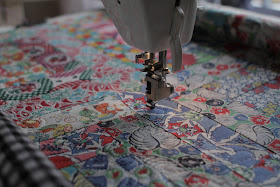
Meet Kate. Kate's been a piecer for years. She's been making quilts since she could hold a needle. But this week, Kate became a quilter! Like most of us, Kate has lots and lots of tops. She loves buying fabric and making blocks but she gets stuck on the quilting part. Sound familiar? ; )
On Saturday, Kate is heading off to Bristol for University and she thought she might let the looming deadline spur her on to finish a couple of quilts. Kate's been enjoying playing around with log cabin blocks. She has two really different looking tops, each utilizing the log cabin pattern.

The top in the photo above, is made from authentic retro fabric purchased on ebay. These blocks have a low contrast, so the log cabin pattern is very subtle.

In the top below, featuring Kaffe fabric, the contrast is more striking.
Kate arranged the blocks to make a zig-zag pattern and framed it with a lovely piano key border.
Kate has never really machine quilted on a frame before. In the past she stuck to stitching lines on the machine and a bit of free-motion. But she was dreading the hassle of fighting with all the fabric under the arm of her sewing machine. And she very much wanted to finish the quilts in time for Uni. So she came to visit a little bit worried that she would not be able to do it.

She worried in vain! While I was pinning the quilt on the frame I had Kate do some doodling practice. She was going to use a mussel shell design and add some scalloping. So she practised first on a roll of paper. By the time the quilt was loaded she was ready to give it a go. The hardest part was 'hitting that red START button!' Well, Kate went from naught to 60 in about 1 hour. In no time at all she was confidently moving the carriage to create beautiful lines, 6 hours later Kate had fallen in love with texture and finished her first quilt.
Today we loaded the second top on the frame. Kate used the same line design with different thread and a looser pattern. After all the practice on the previous quilt, this was easy and Kate was finished in a couple of hours. Three days, two quilts. Not bad!
Kate was thrilled with the difference the quilting made. She's already looking forward to the next one.





















 Now I’m exhausted, yet ridiculously pleased with myself for actually quilting a quilt!!
Now I’m exhausted, yet ridiculously pleased with myself for actually quilting a quilt!!






















